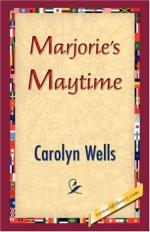But the Maynards were energetic young people, and when interested, they worked diligently; and the result was they accumulated a large number of dolls to sell at the Festival.
King was given his choice between pushing a tinware cart with another boy, or pushing the doll cart for the girls.
He chose the latter, “because,” said he, “I can’t leave Mopsy to the tender mercies of that grumpy girl. And I don’t think tinware is much fun, anyhow.”
“How do we know where to go. Cousin Ethel?” said Marjorie, who was greatly interested in the affair.
“Oh, you just go out into the streets, and stop at any house you like. There won’t be any procession. Every peddler goes when and where he chooses, until all his goods are sold.”
“Suppose we can’t sell them?” said Kitty.
“There’s no danger of that. They’re all inexpensive wares, and the whole population of Cambridge is expecting you, and the people are quite ready to spend their money for the good of the cause”
CHAPTER XX
THE FESTIVAL
Fortunately, the day of the Festival was a perfectly beautiful, balmy, lovely spring day. The affair had been well-advertised by circulars, and the residents of Cambridge had laid in a stock of small change, with which to buy the wares of the itinerant peddlers.
All was bustle and merriment at the Bryant home. The children were to start from there at about ten o’clock, and they were now getting on their costumes.
Each peddler was expected to dress appropriately to the character of the goods he was selling. This was not always an easy matter, but much latitude was allowed; and so a Greek peddler sold pastry, an Italian peddler sold peanuts, and an Indian Chief sold baskets and little Indian trinkets. There were many others, selling notions, fruits, and even fresh vegetables. One boy trundled a peanut roaster, and another was a vendor of lemonade.
When ready to start, the Maynard children and their carts presented a pretty appearance. The dolls were arranged in a light pushcart, borrowed from the grocer. It was decorated with frills of crepe paper, and big paper bows at the corners. In it were more than a hundred dolls, ranging from the elaborately-dressed French beauties to the funny little puppets the children had made.
Marjorie and Bertha Baker were themselves dressed to represent dolls. Marjorie’s dress was of pink muslin, frilled with lace, and a broad pink sash, tied low, with a big bow in the back. A frilled bonnet of pink muslin and lace crowned her dark curls, and she had been instructed by Cousin Ethel to walk stiffly, and move jerkily like a jointed doll. Bertha’s costume was exactly like Marjorie’s except that it was blue, and as Bertha’s hair was blonde and curly, she looked very like a Bisque doll. But Bertha’s face wore naturally a discontented expression, which was far less doll-like than Marjorie’s smiling countenance.




